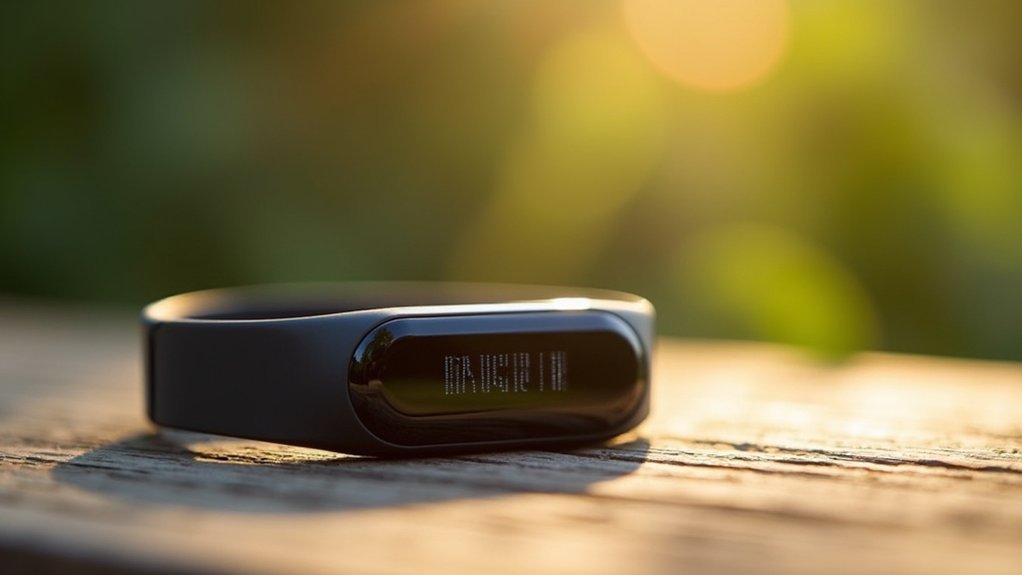You’ve likely struggled with your fitness tracker’s battery life, constantly searching for an outlet or USB cable. What if your device could charge itself using ambient light? Solar-powered fitness trackers are revolutionizing wearable technology, offering a sustainable solution to traditional charging methods. By integrating semitransparent solar cells, these innovative devices capture energy from both natural and artificial light sources. Intrigued by the potential of self-sustaining wearables? The future of fitness tracking might just be illuminating.
Key Takeaways
- Solar fitness trackers utilize semitransparent photovoltaic cells integrated into device surfaces, capturing energy from sunlight and artificial light sources to extend battery life.
- Top brands like Garmin, Suunto, and Citizen offer innovative solar charging technologies that provide continuous power generation for smartwatches and fitness tracking devices.
- Solar-powered fitness trackers significantly reduce electronic waste and carbon footprint by eliminating frequent battery replacements and leveraging renewable solar energy for device operation.
- Current solar charging technologies can generate power in various light conditions, enabling fitness trackers to maintain functionality through direct sunlight and ambient indoor lighting.
- Performance limitations include small solar surface areas and potential energy capture inefficiencies, which manufacturers are addressing through emerging technologies like perovskite solar cells and intelligent energy management.
Understanding Solar Charging Technology
How do fitness trackers harness the power of the sun? Solar charging capabilities in smart wearables leverage cutting-edge solar technology through semitransparent solar cells integrated directly into the watch face. These innovative cells capture energy from both direct sunlight and artificial light sources, dramatically extending battery life without traditional charging methods.
Benefits of Solar-Powered Fitness Trackers

Since the advent of solar-powered fitness trackers, athletes and tech enthusiasts have gained unprecedented advantages in wearable device performance and sustainability. You’ll discover that solar energy transforms your fitness tracker into an unlimited battery powerhouse, dramatically extending usage time without frequent recharging. These innovative wearable technology devices efficiently convert sunlight into electrical energy, ensuring peak functionality even in low-light environments.
How Solar Chargers Work in Wearable Devices

When integrated into modern fitness trackers, solar chargers harness photovoltaic technology to transform sunlight into electrical energy through strategically embedded semitransparent solar cells. You’ll find these innovative cells spanning the entire device display, capturing solar energy from multiple angles with remarkable efficiency.
The solar charging technology enables power generation whether your device is on or off, with off mode proving most effective for energy collection. Advanced materials like Power Glass enhance solar cell performance, ensuring durability and consistent power generation. These semitransparent layers convert sunlight directly into electrical charge, considerably reducing your reliance on traditional battery replacements.
Top Brands Offering Solar Charging Options
The solar-powered fitness tracker market has rapidly evolved, with several innovative brands pioneering solar charging technology in wearable devices. When exploring smartwatches with solar capabilities, you’ll discover standout options across multiple manufacturers:
- Garmin’s Power Glass: Leading the market with Best Garmin Watches like the Instinct series, offering efficient solar energy capture for outdoor enthusiasts.
- Suunto’s Performance Models: The Suunto 9 Baro demonstrates exceptional charging technology, providing extended battery life through integrated solar panels.
- Citizen’s Eco-Drive: Leveraging extensive solar watch designs that continuously recharge, eliminating traditional battery replacement needs.
These brands understand that modern athletes require robust, sustainable wearable technology. Their solar-powered solutions transform how you track fitness metrics, ensuring uninterrupted performance monitoring during intense outdoor activities while minimizing environmental impact through renewable energy integration.
Maximizing Solar Charging Efficiency

Although solar charging technology continues to advance, maximizing its efficiency requires strategic implementation and understanding of key operational principles. Position your solar panel directly towards the sun to enhance energy capture, ensuring your fitness tracker absorbs maximum sunlight during outdoor activities. Wear the device on the outside of your wrist to prevent any panel obstruction, allowing uninterrupted solar exposure.
Consider the sun’s positioning and weather conditions to improve charging performance. During peak sunlight hours, turn off your device to enable uninterrupted energy absorption. Consistent sunlight exposure is critical for sustaining battery life, so integrate regular charging strategies into your daily routine. By understanding these technical principles, you’ll effectively leverage solar charging technology and maintain peak power levels for your smart fitness tracker.
Environmental Impact of Solar-Powered Wearables
As sustainable technology advances, solar-powered wearables emerge as a pivotal solution in reducing electronic waste and mitigating environmental degradation. You’ll discover their significant ecological benefits through:
- Minimized Carbon Footprint: By harnessing renewable solar energy, these devices dramatically decrease reliance on fossil fuel-based energy sources.
- Waste Reduction: Solar-powered fitness trackers substantially lower electronic waste by eliminating frequent battery replacements and disposable charging infrastructure.
- Sustainable Manufacturing: The production of solar cells increasingly incorporates environmentally conscious materials and processes, further reducing overall environmental impact.
When you choose solar-powered wearables, you’re not just selecting a technological device; you’re making a conscious decision to support sustainable practices. These innovative devices transform how you interact with technology, enabling environmentally responsible consumption while maintaining high-performance tracking capabilities. Solar technology represents a strategic approach to balancing technological advancement with ecological preservation.
Comparing Solar Charging vs. Traditional Charging Methods
While technological advancements continue to reshape personal fitness tracking, solar charging emerges as a transformative alternative to traditional power sources. By converting sunlight directly into electrical energy, solar charging considerably enhances user experience compared to conventional charging methods. You’ll find that solar-powered fitness trackers can extend battery lifespan considerably, reducing the frequency of plug-in charging cycles and minimizing battery degradation.
Unlike traditional charging, solar technology allows your device to accumulate energy from both direct and indirect light, providing unprecedented operational autonomy. Your fitness tracker can now continuously operate during outdoor activities without the burden of carrying additional charging cables. This innovative approach not only increases device reliability but also offers a more sustainable and convenient power management solution for tech-savvy fitness enthusiasts.
Limitations and Challenges of Solar Fitness Trackers
Despite technological promise, solar fitness trackers encounter significant performance constraints that challenge their widespread adoption. You’ll find these devices struggle with critical limitations:
- Energy Capture Inefficiency: Small solar component’s surface area restricts battery charging capacity, compromising sustained performance in real-world conditions.
- Environmental Vulnerability: Solar charging effectiveness dramatically fluctuates with weather patterns, sunlight angles, and ambient light conditions, creating unpredictable power generation.
- Durability Concerns: Cutting-edge technology must withstand rigorous outdoor activities, yet solar panels remain susceptible to wear and potential degradation, potentially reducing device longevity.
These challenges underscore the complex engineering required to transform solar fitness trackers from promising concept to reliable consumer technology. While innovation continues, current iterations demonstrate significant technical hurdles in achieving consistent, dependable solar charging performance across diverse usage scenarios.
Maintenance and Care for Solar-Powered Devices
Preserving the functionality and longevity of solar-powered fitness trackers demands meticulous maintenance strategies that directly impact device performance. You’ll want to consistently clean the solar panel with a soft, lint-free cloth to enhance charging efficiency and maintain durability. By wearing your device on the outside of the wrist, you’ll maximize sunlight exposure and boost solar charging capabilities.
Store your solar fitness tracker in a cool, dry environment when not in use to prevent battery degradation. Avoid exposing the device to extreme temperatures, which can compromise internal components and reduce user comfort. Regularly check for manufacturer software updates to improve solar charging performance and guarantee peak device functionality. These maintenance practices will help you extend the life and reliability of your solar-powered fitness tracker.
Future Innovations in Solar Wearable Technology
As technological advancements continue to reshape the landscape of wearable devices, solar technology is poised to revolutionize how we integrate energy harvesting into personal electronics. The future of solar wearables promises transformative innovations that’ll enhance both functionality and user experience:
- Perovskite solar cells will dramatically improve energy conversion efficiency, enabling lightweight, flexible solar components seamlessly integrated into fitness trackers and health monitoring devices.
- Nanotechnology-enhanced solar materials will create more durable, lightweight energy-capturing textiles that can withstand daily wear while maintaining peak solar energy generation.
- AI-driven optimization will allow wearable solar devices to intelligently manage energy consumption, adapting to environmental conditions and personal usage patterns.
These developments signal a new era of intelligent, self-sustaining wearable technologies that’ll redefine personal energy management and health tracking capabilities.
Frequently Asked Questions
Do Solar Portable Chargers Actually Work?
You’ll find solar chargers do work, but their efficiency depends on solar exposure, weather conditions, and device compatibility. They’re slow yet portable, providing reliable backup power when traditional charging isn’t accessible, especially in outdoor environments.
Can I Charge Other Devices With a Solar Charger?
You can charge alternative devices with solar chargers, leveraging portable convenience and solar technology. Check device compatibility, output specs, and charging efficiency to guarantee peak performance across smartphones, tablets, and other electronics.
How Long Does a Solar Charger Last?
You’ll find a quality solar charger can last 20-25 years with proper maintenance. Its efficiency depends on panel quality, sunlight exposure, and regular care. Ideal charging times vary, but consistent maintenance guarantees longer, reliable performance for your devices.
What Are the Disadvantages of Solar Mobile Chargers?
Where sunlight meets technology, solar chargers falter: you’ll face efficiency concerns, weather dependence, higher costs, and limited compatibility. Their performance drops in cloudy conditions, making them less reliable than traditional charging methods for your devices.
Conclusion
You’re witnessing a transformative era in wearable technology where solar fitness trackers could reduce electronic waste by up to 40%. By embracing these innovative devices, you’re not just tracking your fitness but contributing to sustainable tech evolution. The integration of semitransparent solar cells represents more than a charging solution—it’s a strategic approach to minimizing environmental impact while enhancing personal performance tracking capabilities.




